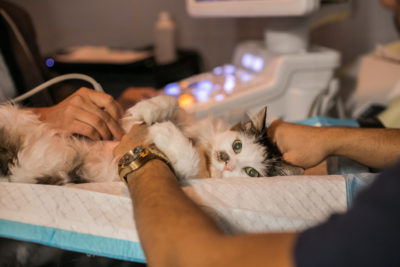The Top 5 Reasons Cats Visit AMC’s Emergency Room

The Top 5 Reasons Cats Visit AMC’s Emergency Room
June is Adopt-a Cat Month. For the entire month, I will devote my blog posts to issues important to feline families. Today’s post reviews the top causes of feline emergency room visits at AMC.
#1 Blocked Cats
Because the urine tube (urethra) of male cats is narrow and long, male cats are prone to urinary obstruction. If your male cat runs in and out of the litter box frequently, crying and not producing any urine, you should take him to the ER immediately. This is a life-threatening condition, and early detection is critical.
#2 Kidney Disease
Cats are the masters of medical disguise. They can hide an illness until the situation is dire. This explains why a chronic problem like kidney disease often looks like an emergency to a cat’s family. To them their cat suddenly stops eating and has lost weight, so they decide to head to the ER. However, the most common form of feline kidney disease is an irreversible condition that requires ongoing treatment and therapy.
#3 Fractures
Most fractured bones in cats are due to trauma – automobile accidents or, in places like New York City, falls from tall buildings. You can prevent automobile accidents by making your cat an indoor cat, and if you live in a tall building, be sure your terrace, balcony and windows are cat-proof to prevent an inadvertent fall to the hard ground below.
#4 Ingestion of Foreign Objects
The top item removed from cats by the ER doctors was a linear foreign body: string, yarn or thread. Linear foreign bodies bunch up the intestine and can slice into the intestinal wall. Linear foreign bodies require surgical removal, and if the intestinal wall has been damaged, removal of the damaged section may be necessary. Cat families should keep string, yarn and thread safely inside a cabinet.
#5 Heart Failure
Heart disease is a common cause of illness and death in cats. The feline heart muscle becomes very thick with poor function, a condition known as hypertrophic cardiomyopathy. When blood is not efficiently pumped, fluid builds up in the lungs and blood cannot be oxygenated. Your cat’s respiratory rate will climb in an attempt to compensate. Once the respiratory rate exceeds 40 breaths per minute, cat owners recognize their cat is in distress and head to the ER. Learning to count your cat’s respirations before she has a problem can help you to recognize signs of heart failure early.
Not making the top five, but still occurring frequently were anemia, low blood sugar, diarrhea, poor appetite and various types of masses.
Everyone wants to avoid a trip to the emergency room, but sometimes an ER visit is necessary. I hope this list helps cat families recognize some of the more common feline emergencies.




























